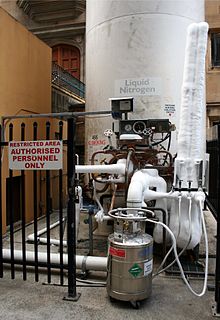Cryogenics - Simple English Wikipedia, the free encyclopedia



In physics, cryogenics is the production and behaviour of materials at very low temperatures.
It is not well defined at what point on the temperature scale refrigeration ends and cryogenics begins. A gas may be cryogenic if it can be liquefied at or below −150 °C (123 K; −238 °F).[1]
The U.S. National Institute of Standards and Technology considers cryogenics as involving temperatures below −180 °C (93 K; −292 °F). The normal boiling points of helium, hydrogen, neon, nitrogen, oxygen, and normal air are below −180 °C.
The Freon refrigerants, hydrocarbons, and other common refrigerants have boiling points above −180 °C.[2][3]
Discovery of superconducting materials has raised interest in reliable, low cost methods of producing high temperature cryogenic refrigeration. The term "high temperature cryogenic" means temperatures from above the boiling point of liquid nitrogen, −195.79 °C (77.36 K; −320.42 °F), up to −50 °C (223 K; −58 °F).[4]
Cryogenicists use the Kelvin or Rankine temperature scale, both of which measure from absolute zero, rather than more usual scales such as Celsius which measures from the freezing point of water at sea level or Fahrenheit with its zero at an arbitrary temperature.
Uses[change | change source]
- Magnetic resonance imaging is an important machine for hospital diagnosis. It shows internal damage to soft tissues, and is very important in brain surgery.
- Nuclear magnetic resonance is used for the physical and chemical properties of atoms.
- Rocket cryogenic fuel is used as a propellant.
- Cryogenics create the temperatures needed to store or transport large amounts of food without it deteriorating.
- Many physical experiments need cryogenic temperatures.
- Underground cables transmitting electricity are made much more efficient if they are cooled to cryogenic temperatures.
Related pages[change | change source]
References[change | change source]
- ↑ Bilstein, Roger E. (1996). Stages to Saturn: A Technological History of the Apollo/Saturn Launch Vehicles (NASA SP-4206) (The NASA History Series). NASA History Office. pp. 89–91. ISBN 978-0-7881-8186-3.
Cryogenics.
- ↑ "DICHLORODIFLUOROMETHANE at Pubchem".
- ↑ "PROPANE at Pubchem".
- ↑ J. M. Nash 1991. Vortex expansion devices for high temperature cryogenics. Proc. of the 26th Intersociety Energy Conversion Engineering Conference, 4, pp. 521–525.


 French
French Deutsch
Deutsch